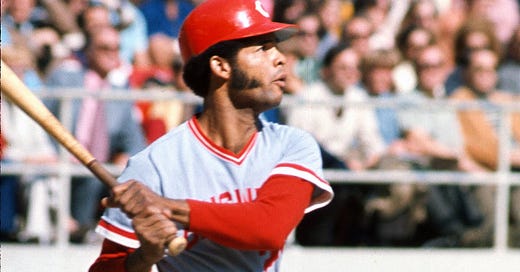Bobby Tolan’s Impact on Reds a Narrative of Peaks and Valleys
Tolan was as a dynamic force in the Reds' lineup during a crucial period in the development of the Big Red Machine
One of the players I admired when I first developed an interest in baseball was Bobby Tolan. His distinctive batting stance, adept bunting skills, base-stealing prowess, and versatile hitting made him stand out on the field. Tolan’s impact on the Cincinnati Reds reflects a narrative of both peaks and valleys in the career of this enigmatic outfielder.
In 1969, Tolan burst onto the scene after being acquired from the St. Louis Cardinals, filling the shoes of Reds legend Vada Pinson with a stunning Opening Day home run. This set the stage for a stellar four-year stint, positioning him as a linchpin in the emerging Big Red Machine.
The pinnacle arrived in 1972, as Tolan not only secured the Comeback Player of the Year after missing all of the 1971 season after rupturing his Achilles tendon while playing basketball, but also clinched the coveted Hutch Award for his resilience. However, the story took a bitter turn in the decisive Game 7 of the 1972 World Series against the Oakland A’s when he uncharacteristically misplayed two balls in center field, foreshadowing the struggles that would mar the 1973 season.
Acknowledged by Reds’ Manager Sparky Anderson as a managerial failure, Tolan's decline persisted despite interventions from Reds’ luminaries like Pete Rose and General Manager Bob Howsam. The once-dynamic player found himself traded to the San Diego Padres at the close of the disastrous 1973 season, signaling the end of his time in Cincinnati.
In Tolan’s four-year tenure donning the Reds' uniform, he left an enduring mark on the field. Over the course of 582 games, Tolan's stat line paints a vivid picture of his talent: 645 hits, comprising 101 doubles, 23 triples, and 54 home runs. His offensive prowess extended to 306 RBIs, while his speed on the bases saw him amass an impressive 140 stolen bases.
Tolan's consistency at the plate reflected in his .282 batting average, coupled with a commendable .335 on-base percentage. Beyond the basics, he showcased power with a slugging percentage of .417, contributing to a robust .752 OPS (On-base Plus Slugging).
These numbers not only underscore Tolan's versatility but also solidify his legacy as a dynamic force in the Reds' lineup during a crucial period. His statistical achievements complement the narrative of his baseball career, providing a numerical testament to the impact he had on the team's success.
Questions linger about the factors behind Tolan's decline — was it a fading skill set, diminishing speed, or a combination of both? Anderson's admission of regret underscores the complexity of managing such situations.
Despite the disappointing end to his once-promising baseball career, Tolan remains a pivotal figure in Reds history, earning a spot among the franchise’s Top 10 center fielders and contributing to the genesis of the Big Red Machine.





